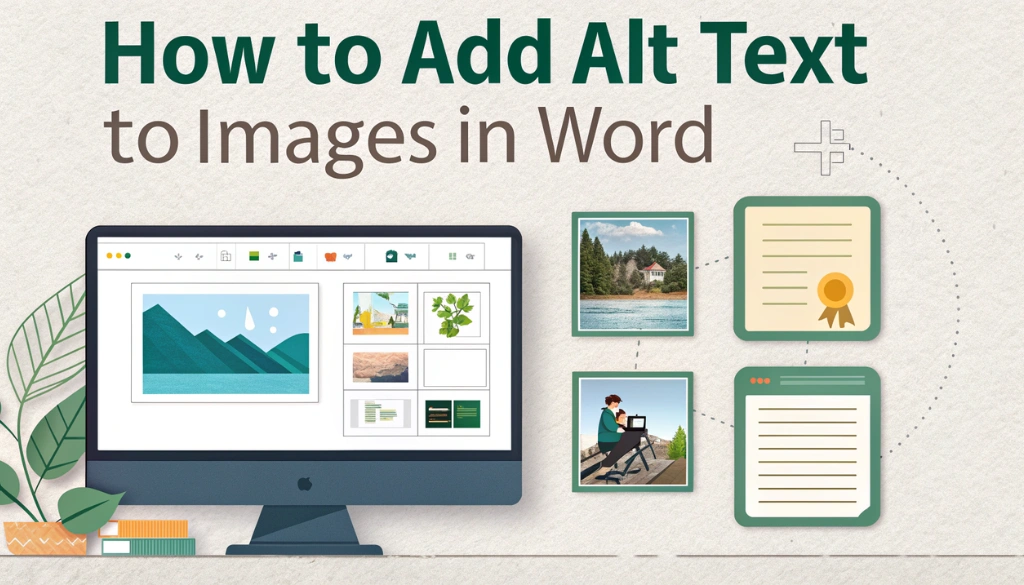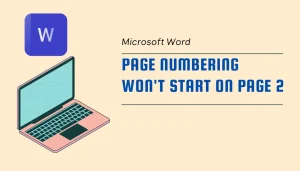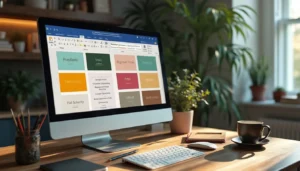Last Updated: January 23, 2025
Adding alt text to images in Microsoft Word is critical for improving image accessibility. Alt text enables screen readers to convey the meaning of images, which is especially significant for users with visual impairments. By creating clear and descriptive alt text, we improve the in general user experience.
This article outlines simple steps for incorporating alt text into images in Word, along with effective tips for crafting it. Together, we can improve document accessibility and lift SEO optimization!
Table Of Contents
Methods to Add Alt Text in Microsoft Word
Adding alt text in Microsoft Word is necessary for improving image accessibility. Alt text provides descriptive text for images, making them understandable for users who rely on screen readers. Here’s how to add alt text:
- Select the image: Click on the image you want to describe.
- Right-click: Open the context menu and choose Edit Alt Text.
- Enter a description: In the Alt Text pane, provide a clear and concise description of the image.
- Mark as decorative: If the image is purely decorative, check the box to indicate this.
By following these steps, you make your visual content accessible to everyone, including those with visual impairments. This practice not only complies with accessibility standards but also enhances the in general user experience. For more tips on document formatting, check out our resources.
Including an image description enriches your content and supports assistive technology. This practice benefits users and improves SEO optimization for your documents.
Right-click and Edit Alt Text
To add alt text in Microsoft Word, right-click on the image. This opens a context menu where you can select Edit Alt Text. A pane will appear, allowing you to input a clear and concise description. This step is critical for image accessibility, ensuring that users relying on screen readers can comprehend the visual content.
Follow these steps:
- Right-click the image.
- Select Edit Alt Text.
- Provide a meaningful description in the text box.
By completing these steps, you improve web accessibility and improve the in general user experience. If the image is purely decorative, indicate this to inform assistive technology that no description is necessary, aligning with accessibility standards in Microsoft Word.
For more tips on document formatting, explore our document editing resources.
Using the Format Menu
Enhancing image accessibility in Microsoft Word is easy with the Format Menu. Simply right-click on the image and choose Edit Alt Text. This opens a pane where you can input descriptive text for screen readers, aiding users with visual impairments in understanding the content.
Or, click the Alt Text button in the Format ribbon tab to swiftly add or update image descriptions. This practice not only improves web accessibility but also enhances the in general user experience. For additional tips on document formatting, check out the link.
Always make sure every image includes alternative text. If an image serves a decorative purpose, mark it therefore. This informs assistive technology that no description is needed, aligning with accessibility standards and testing your page layout clean.
Utilizing the Format Menu in Microsoft Word is critical for adding alt text to images, making your documents inclusive and accessible for all users.
Best Practices for Writing Effective Alt Text
Writing effective alt text is critical for enhancing image accessibility. Alt text allows users with visual impairments to understand the content of images. Here are necessary best practices for consideration:
- Be Descriptive: Offer a vivid description of the image and its context. For example, instead of saying “Image of a dog,” write “A golden retriever joyfully playing fetch in a sunlit park.”
- Keep it Concise: Limit your description to 1-2 sentences. Remove unnecessary details that don’t add value.
- Avoid Redundancy: Don’t repeat information already provided in the surrounding text.
- Mark Decorative Images: If an image has no informational purpose, label it as decorative. This allows screen readers to skip it, improving navigation.
To add alt text in Microsoft Word, follow these steps:
- Right-click the image and select Edit Alt Text.
- Enter a clear description in the Alt Text pane.
By following these guidelines, you improve web accessibility and improve the in general user experience for everyone.
Contextual Relevance
Contextual relevance is necessary when writing alt text for images. It ensures the description accurately identifies the image and clarifies its significance within the document. This is especially significant for users relying on screen readers, as they need to understand how the visual content relates to the surrounding text.
When creating alt text, prioritize the user experience. For instance, if an image depicts a dog in a park, an effective alt text could be, “A golden retriever joyfully playing fetch in a sunny park.” This description helps users visualize the scene, although they cannot see it.
Employing descriptive language greatly enhances web accessibility. To improve your documents, follow these best practices:
- Be concise: Use clear, brief sentences.
- Include context: Explain how the image connects to the text.
- Use semantic markup: This aids search engines in understanding your content.
For additional tips on enhancing your Microsoft Word documents, check out header and footer creation techniques.
By crafting image descriptions that are relevant and informative, we create a more inclusive digital environment. This not only assists users with disabilities but also enhances our SEO optimization, making our content more discoverable.
Conciseness and Clarity
Conciseness and clarity are necessary when creating alt text for images. Descriptions should be brief yet informative, helping users, particularly those with screen readers, grasp visual content without unnecessary detail. For example, instead of saying, “This is an image of a cat sitting on a couch,” simply write, “Cat sitting on a couch.”
When crafting alt text, focus on the image’s purpose and its relevance to surrounding content. This approach enhances web accessibility and improves the in general user experience. For instance, describe a remodeled kitchen as “Modern kitchen with stainless steel appliances.” This provides context without overwhelming the reader.
To write effective alt text, follow these best practices:
- Be specific: Clearly describe the image’s contents.
- Keep it short: Limit descriptions to 1-2 concise sentences.
- Use descriptive language: Avoid vague terms to improve clarity.
Mark images as decorative when they lack meaningful information, indicating to users that no significant details are overlooked. For more tips on improving document accessibility, explore different resources.
By adhering to these guidelines, we can create image descriptions that are clear and effective, ensuring all users can fully engage with our content. The goal is to make digital images accessible and informative for everyone.
Importance of Alt Text for Accessibility
Adding alt text to images in Microsoft Word is critical for enhancing accessibility. Alt text offers descriptions that allow individuals using screen readers to grasp visual content. This is especially significant for users with visual impairments, as it conveys the context and significance of images within documents.
To add alt text, follow these simple steps:
- Right-click the image: Choose “Edit Alt Text.”
- Enter a description: Provide clear, meaningful text that accurately describes the image.
- Review auto-generated text: Make sure it accurately reflects the image content.
Effective alt text not only enhances user experience but also improves SEO optimization. Search engines rely on alt text to index images, boosting web accessibility and ensuring compliance with accessibility standards. For more detailed guidance, consult resources like alternative text guidelines.
Incorporating alt text into digital images fosters an inclusive environment, allowing everyone to access and understand rich content. By implementing these practices, we contribute to a more accessible and equitable digital world.
Enhancing Screen Reader Experience
Enhancing the screen reader experience starts with prioritizing alt text for images. This critical descriptive text helps users with visual impairments understand visual content. In Microsoft Word, adding alt text is easy: right-click an image and select Edit Alt Text. This practice not only meets accessibility standards but also elevates the in general user experience.
- Descriptive Context: Alt text should accurately describe the image and its relevance to the surrounding content.
- Automatic Features: Activate automatic alt text generation in Word’s accessibility settings for faster updates.
- Compliance: Following these practices ensures adherence to digital accessibility guidelines.
Implementing these strategies makes content accessible to everyone. For detailed instructions, check out this effective alt text guide.
Compliance with Accessibility Standards
Compliance with accessibility standards is critical for ensuring digital content is accessible to all users. Adding alt text to images in Microsoft Word greatly enhances image accessibility for individuals who rely on screen readers. This descriptive text not only improves the user experience but also aligns with web accessibility guidelines.
- Descriptive text: Alt text should clearly express the image’s meaning and context.
- Assistive technology: Screen readers use this text to narrate images for visually impaired users.
- SEO optimization: Thoughtfully crafted alt text can improve search engine rankings.
To add alt text, right-click on an image in Word and select Edit Alt Text. This opens a pane for entering your descriptions. For detailed guidance, check out this resource.
By implementing these practices, we create content that is both informative and inclusive, fostering disability inclusion and improving in general digital accessibility.
Summing up
Adding alt text to images in Word is critical for accessibility. It allows screen reader users to understand visual content effectively. Crafting clear and descriptive alt text enhances the in general user experience. Meaningful alt text should connect the image to the surrounding text, providing clarity and context. This practice not only meets accessibility standards but also boosts our SEO performance. Let’s create inclusive and accessible documents for everyone.
Frequently Asked Questions
How do you write effective alt text for a picture?
Effective alt text should be concise, descriptive, and contextually relevant, conveying the image’s purpose and meaning clearly.
How do I add alt text for images in Word?
Right-click the image, select “Edit Alt Text,” and enter a concise, meaningful description to improve accessibility.
Can you edit alt text after adding it to images in Word?
Yes, you can edit alt text in Word anytime by right-clicking the image and selecting “Edit Alt Text.” It’s that simple!
Why is alt text significant for images in Word documents?
Alt text ensures images are accessible to all, providing context for visually impaired users and enhancing document understanding.





